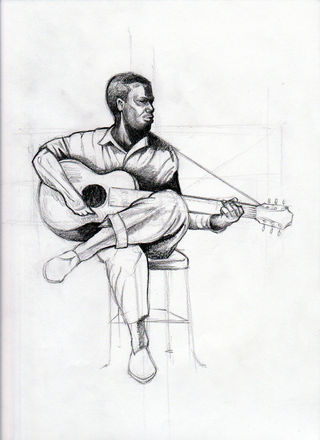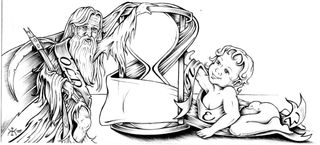
Identity
Art Set Him Free: A Former Prison Inmate's Story
One man explains how art helped him get through prison.
Posted May 26, 2016
About a month ago, I received a phone call from Keith Kilby. He wanted to interview me for an assignment for one of his college courses. He indicated he was interested in becoming an art therapist working with people in prison. He was in the middle of obtaining his Associates Degree and had already begun speaking with a director for a graduate art therapy program, and seemed clear on how he would accomplish it.
Oh, and by the way—he had also spent several terms in prison, during which he himself used his time to create art.

He had come a long way since his most recent incarceration. The more I spoke with him, the more I was fascinated with his story.
His is a true account of what art was able to achieve for him--to help him break free of the label and provide him options he may not otherwise have had.
Although he called to interview me, he agreed to be interviewed himself. We communicated via email and Skype over the next couple of weeks.
His story is a lengthy one—certainly more than I can communicate in 1500 words [granted, I recognize I just wasted 20 words stating this]—but this post reflects the most salient points. All of the information below is from Keith’s memory and perspectives.

Keith, who is currently 50 years old, had been arrested and imprisoned on four separate occasions, in four separate states, all for self-described “stupid reasons;” drinking, being in the wrong place at the wrong time, trumped up charges, false allegations made by disgruntled loved ones—all times served, none for violent behavior. All of his sentences combined meant he spent almost 11-and-a-half years in prisons.
The first time he went to prison was in Texas in the early 1990s. He left for California from his home in Atlanta to pursue his dream of playing music with the metal band Dark Overlord. After suffering a head injury from a car accident, his music career began to wane. Frustrated and let down he became addicted to cocaine. Thus, the decisions he made were not always sound.
He decided to return to Atlanta to turn his life around. On the way, he stopped in Texas to see his family. One day, while sitting in a bar, he struck up a conversation with a man who eventually asked him to help with his pest control work. He agreed. Keith drove the man to an extermination company, but was surprised when the man jumped the locked fence and stole a termite drill. When the police came he was also arrested for stolen property—the police believed that his own possessions in his van were ill gotten. Unfortunately, he couldn't prove the stuff was his and, as he was present at the scene of the crime, he was indicted. He received a year in a work release program and probation.

Still struggling with his addiction, and believing he could leave Texas to go back to Atlanta after being discharged from the work release program, he was arrested in Atlanta for possession of pot. As he was not actually supposed to leave Texas, he was extradited back, and given a 3-year sentence on a felony fugitive warrant.
After completing his sentence and his parole, he moved back to Atlanta. However, because of misunderstandings regarding his drivers’ license [too convoluted and confusing to outline here], he was arrested over the state line in South Carolina driving on a suspended license and eluding the police who attempted to pull him over. After coming to an abrupt stop when he hit a fence at the end of a road, he was subsequently arraigned and he received a year sentence, for which he did 8 months.

Upon release, he went back to Atlanta and had to answer for the night he left Georgia to go to South Carolina on the suspended license. Although he had never been stopped, tested nor charged for it in South Carolina, Georgia tacked on a DUI to the suspended license and failure to stop at a “blue” light (the police)—he was given a five year sentence for which he served a little over 3 years.
Upon completing his sentence and the subsequent parole he followed his new wife to Michigan. The marriage quickly dissolved, but they remained close. However, after a fairly disagreeable night at her home, the police pulled him over. His ex filed a complaint that he was drunk and had beaten her. He was not charged for the domestic violence—for which he vehemently denied—but the DUI stuck. He completed less than 3 years of his 5-year sentence.
It seems apparent what Keith meant by “for stupid reasons.”
However, he had one saving grace. Aside from his music, he was also a free-lance artist. He capitalized on this each time he entered prison.
Every time I’ve been in prison I’ve always, you know, centered myself more around my art…because it was a way to make ends meet [and deal with things]…And of course, there is a kind of hierarchy in prison and when you’re able to provide a service like that, you’re actually gain respect …nicknames are something that people always use in prison, and mine became “the Artist.

He became the unit artist in Texas and worked directly for the warden. He also designed envelopes for himself and others to send out. In South Carolina, after he became the designated “unit artist, “ completing several murals near the visitation areas.
Once in Georgia, Keith approached the warden several times to start an art class. After putting together a formal curriculum, he was eventually granted permission. Over 80 people signed up for the class.
He said he’d let me do it but I could only have one room for x amount of time. Well, I got such an overwhelming response that I [went to him, and told him] ‘this is something that could really benefit the other inmates. As [it] helps people express themselves in amore positive way, I think this would be a benefit to you.’ So he allowed me to actually have two classes…40 students each class.
Set up as a “regular 3-4 month class”, Keith recounted:
There was never even a guard posted. Never had any kind of violent tantrums, [no] problems whatsoever, because they knew this was for them…they didn't want to lose something like that. And there was so much more going on besides learning how to draw from 3 basic shapes and stuff like that. They could feel the art working, you know?
After he taught for a year, he was certified as a fire fighter on the prison fire brigade. He helped fight Georgia's largest wild fire in history -the Ware county fire of 07-and a major fire in downtown Dublin Ga. Shortly after, he moved to Michigan with his wife.

Once incarcerated in Michigan, Keith did not hesitate. Along with working for the prison’s fire brigade, he taught art classes, “and I also did murals in the arts and crafts room. I really liked the way that [I] could build relationships through the art…the art played a major part in my rehabilitation I think…even though, yes, I got trapped a couple of times with minors [charges], things that …snowballed…[such as] driving on a suspended license, DUI…” the art really helped.
Realizing how important the art was for him, Keith wants to use it to help others. Since leaving prison in Michigan, Keith has been focused on a single goal:
When I was teaching art in Michigan, I realized I needed to focus on trying to help other through art and that’s when I realized I needed to go back to school and get a degree, may be as an art therapist….in the ‘80s I heard about art therapy and art education…and one girl I knew, she was studying to be an art therapist.

Currently, Keith is off parole, working and is enrolled in his second year at a local community college, getting A’s and B’s in all his classes. He has already communicated with a director of an art therapy program to determine what he needs to do in order to enter her program.
Rather than succumb to the prison label, the identity that is placed on inmates by our culture, Keith used his art to rise above it. According to Keith, the biggest need amongst his fellow inmates was “Identity…really getting in touch with who they are…and art can help with that.”
------------------------

Postscript: Included in this post is just a small sample of some of his artwork. Along with his paintings and drawings, Keith also writes, including short stories and the children’s book The Broken Halo, published by Tate Publishing [available here]. He has also written several narratives about his experience in prison. An upcoming post will include, in full, one of Keith’s short stories that provide his inside view.



